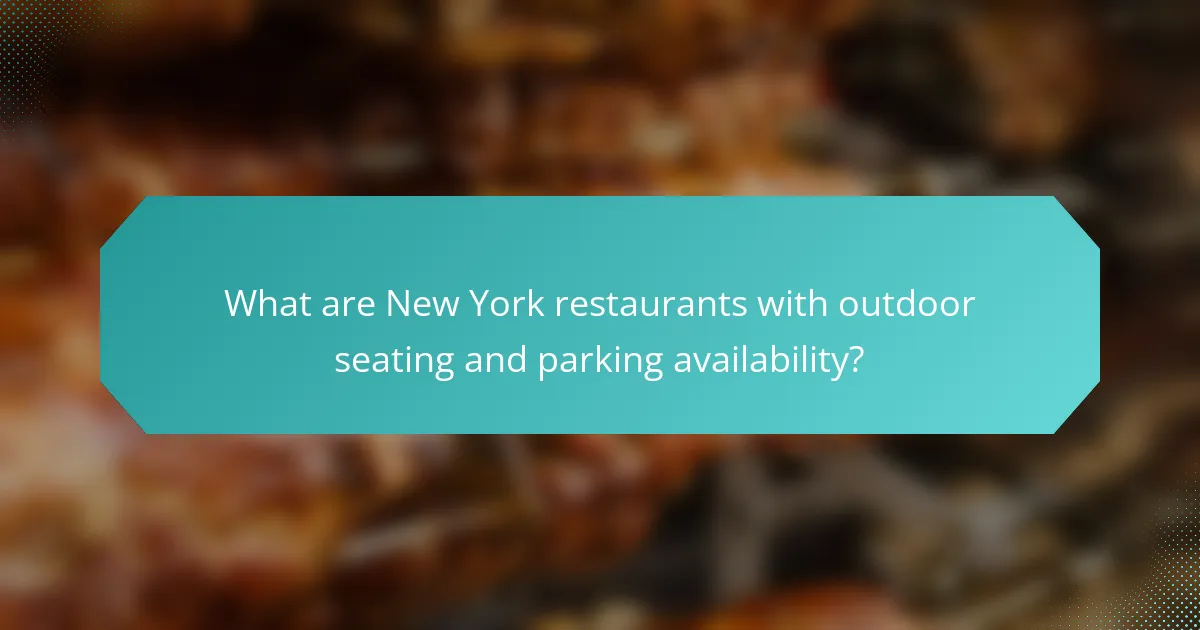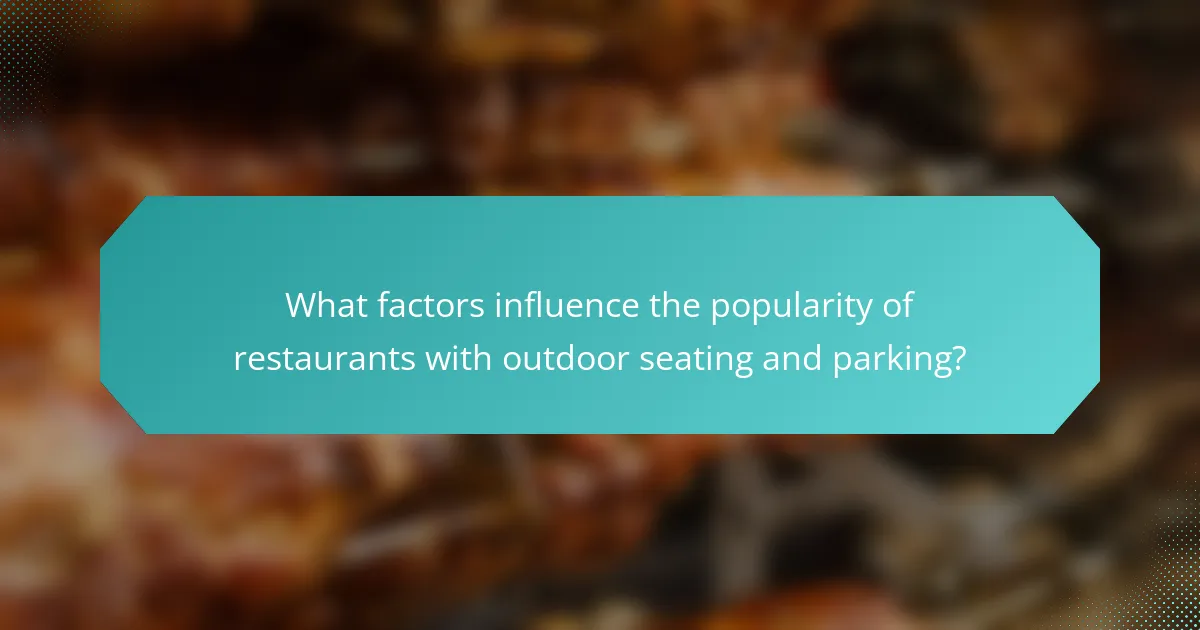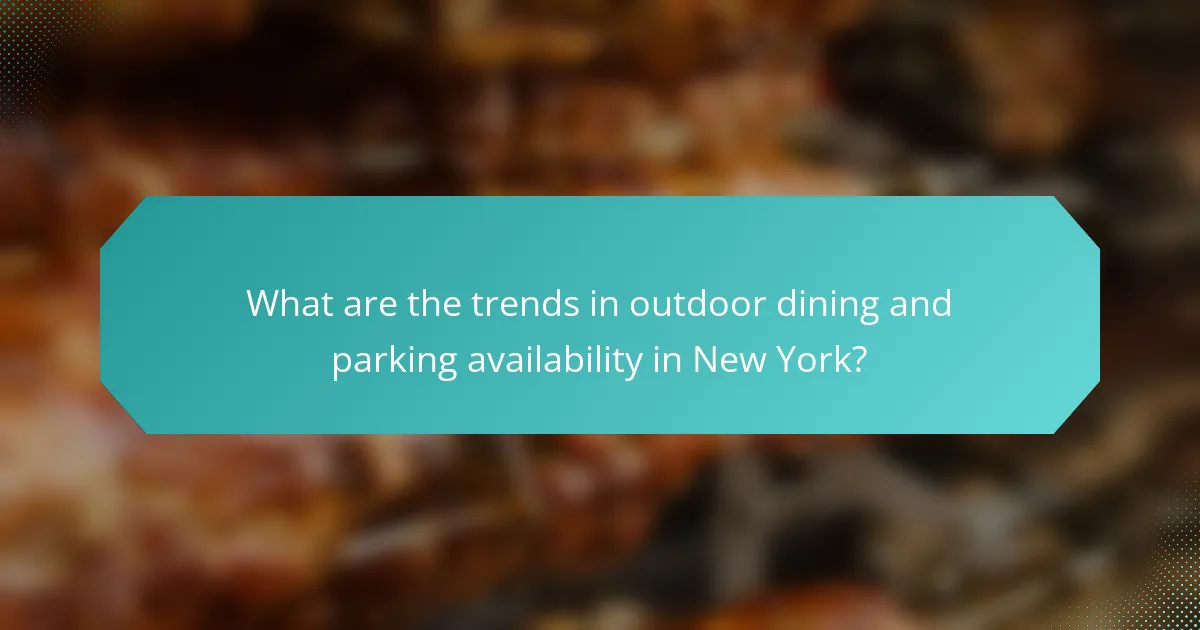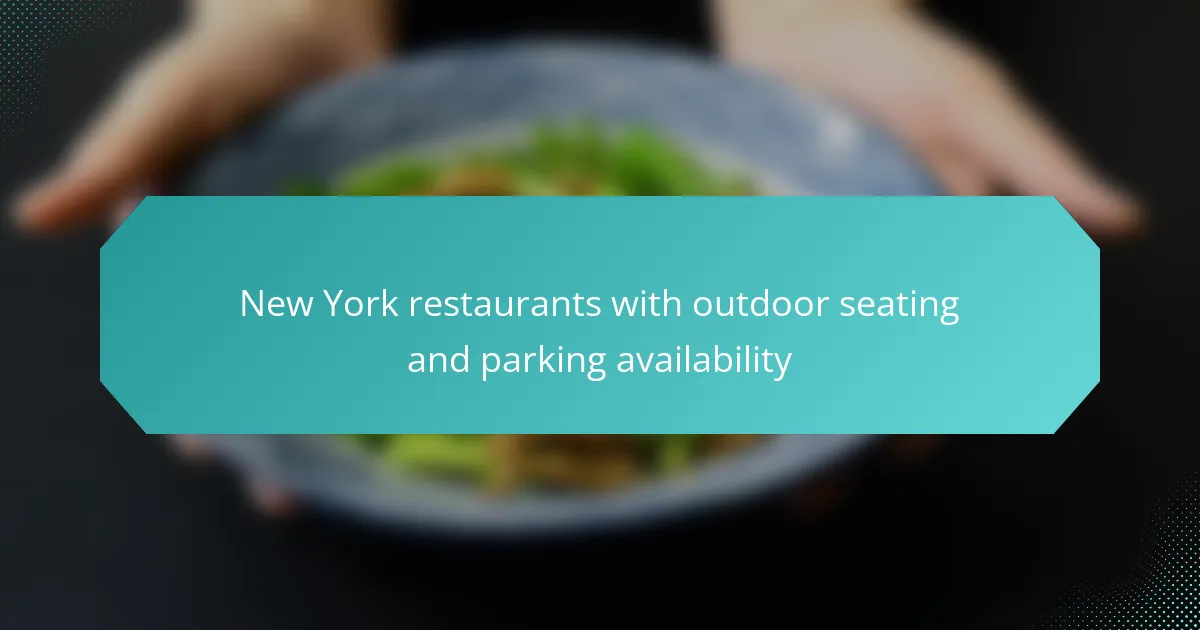New York restaurants with outdoor seating and parking availability are increasingly popular among diners seeking a comfortable and convenient dining experience. Notable establishments such as The Smith, Serafina, and Westville offer outdoor dining options along with nearby parking facilities. The rise in outdoor dining, particularly after the pandemic, has been supported by the city’s Open Restaurants program, which has allowed over 12,000 restaurants to expand their outdoor spaces. However, this trend has also created challenges regarding parking availability, prompting a shift towards alternative transportation methods. The article explores the factors influencing the popularity of outdoor dining and the implications for parking management in New York City.

What are New York restaurants with outdoor seating and parking availability?
New York restaurants with outdoor seating and parking availability include several popular options. For instance, The Smith offers outdoor dining and has a parking lot nearby. Another option is Serafina, which provides outdoor seating and street parking access. Additionally, Westville features outdoor tables and nearby parking facilities. These restaurants cater to guests seeking a pleasant dining experience with convenient parking.
How do outdoor seating and parking availability enhance the dining experience?
Outdoor seating and parking availability significantly enhance the dining experience by providing convenience and comfort. Outdoor seating allows diners to enjoy fresh air and a pleasant ambiance. This setting can improve mood and relaxation, which are essential for a positive dining experience. Additionally, availability of parking reduces stress for guests. Easy access to a restaurant encourages more patrons to visit. Studies show that restaurants with ample parking see higher customer satisfaction rates. A study by the National Restaurant Association indicates that outdoor dining options can increase customer visits by 30%. Thus, both outdoor seating and parking availability directly contribute to a more enjoyable dining atmosphere.
What are the benefits of outdoor seating for diners?
Outdoor seating provides diners with a unique and enjoyable dining experience. It allows patrons to enjoy fresh air and natural surroundings. Studies show that outdoor dining can enhance mood and relaxation. Additionally, it can attract more customers, increasing restaurant revenue. Outdoor seating often provides a social atmosphere that encourages longer visits. This setting can also accommodate larger groups, enhancing dining flexibility. Furthermore, outdoor seating may offer scenic views, enhancing the overall experience. Many diners prefer outdoor options during pleasant weather, making it a desirable feature for restaurants.
How does parking availability impact restaurant choice?
Parking availability significantly impacts restaurant choice. Customers often prefer restaurants with convenient parking options. Limited parking can deter potential diners, leading them to choose alternatives. Studies indicate that 70% of customers consider parking when selecting a restaurant. Restaurants with ample parking often see higher foot traffic. In urban areas, such as New York, parking scarcity is a critical factor. Customers may avoid venues that require extensive searching for parking. This behavior can directly influence a restaurant’s revenue and customer loyalty.
What types of cuisines are offered at these restaurants?
New York restaurants with outdoor seating and parking availability offer diverse cuisines. Common types include Italian, Mexican, Chinese, and American. Many establishments also serve Mediterranean and Indian dishes. Some restaurants focus on farm-to-table concepts. Others may offer fusion cuisines that blend various cultural influences. The variety caters to different dietary preferences and tastes. This diversity enhances the dining experience in New York’s vibrant food scene.
Which popular cuisines can be enjoyed in outdoor settings?
Italian cuisine is popular for outdoor dining. Italian dishes like pasta, pizza, and antipasto are commonly enjoyed outside. These dishes are often served with fresh ingredients, enhancing the outdoor experience. Mexican cuisine is also favored in outdoor settings. Tacos, enchiladas, and guacamole are popular choices. The vibrant flavors complement the casual atmosphere of outdoor dining. Barbecue cuisine thrives in outdoor environments. Grilled meats and vegetables are staples at outdoor gatherings. American barbecue is known for its smoky flavors and hearty portions. Mediterranean cuisine is well-suited for outdoor enjoyment. Dishes like kebabs, hummus, and tabbouleh are refreshing and flavorful. These cuisines enhance the outdoor dining experience through their diverse flavors and communal nature.
Are there specific restaurants known for unique outdoor dining experiences?
Yes, there are specific restaurants known for unique outdoor dining experiences. In New York, several establishments offer distinct outdoor settings. For instance, The River Café features stunning views of the Manhattan skyline. This restaurant is situated on the waterfront in Brooklyn. Another example is 230 Fifth Rooftop Bar, which provides panoramic city views. It is known for its vibrant atmosphere and rooftop gardens. Additionally, The Highline Hotel offers a charming outdoor patio with a historic backdrop. These restaurants enhance the dining experience with their unique outdoor environments.
What are the seasonal considerations for outdoor dining in New York?
Seasonal considerations for outdoor dining in New York include weather variability and temperature changes. Summer offers warm weather, encouraging outdoor seating. However, heat waves can make dining uncomfortable. Spring provides mild temperatures, ideal for outdoor experiences. Rain showers can disrupt dining plans during this season. Fall brings cooler temperatures, prompting the use of heaters for comfort. Winter presents challenges with cold weather and snow, often leading to reduced outdoor seating. Restaurants must adapt by providing heating solutions or seasonal menus. These adaptations are crucial for maintaining customer comfort and satisfaction year-round.
How does weather affect outdoor seating availability?
Weather significantly impacts outdoor seating availability at restaurants. Adverse weather conditions, such as rain or snow, can reduce or eliminate outdoor seating options. Inclement weather leads to decreased patron comfort and safety concerns. High temperatures may also deter customers from dining outside. Conversely, pleasant weather encourages higher outdoor seating usage. Restaurants often adjust seating arrangements based on weather forecasts. Data indicates that outdoor seating can increase by 30% on sunny days. Therefore, weather conditions directly influence both the capacity and desirability of outdoor dining spaces.
What months are best for outdoor dining in New York?
The best months for outdoor dining in New York are typically May through September. During these months, the weather is generally warm and pleasant. Average temperatures range from the mid-60s to the low 80s Fahrenheit. Rainfall is also lower in these months compared to others. Many restaurants open their outdoor seating to accommodate diners. This timeframe aligns with the peak tourist season, increasing the availability of outdoor dining options. Thus, May to September is ideal for enjoying meals outside in New York.
How do New York restaurants accommodate parking needs?
New York restaurants accommodate parking needs by offering valet services, reserved parking spots, and partnerships with nearby garages. Many restaurants provide valet services to streamline parking for guests. This service allows diners to drop off their vehicles at the restaurant entrance. Reserved parking spots are often set aside for patrons, enhancing convenience. Additionally, some restaurants collaborate with local parking garages to offer discounted rates. This partnership can make parking more affordable for customers. Many establishments also provide information about nearby public transportation options. This approach encourages patrons to use alternative travel methods, reducing parking demand. Overall, these strategies help New York restaurants manage parking effectively.
What parking options are commonly available near these restaurants?
Common parking options near New York restaurants with outdoor seating include street parking, parking garages, and valet services. Street parking is often metered and may have time restrictions. Parking garages provide designated spaces for longer durations and are typically located within walking distance of restaurants. Valet services may be available at higher-end establishments, allowing for convenient drop-off and pick-up. Many restaurants also offer partnerships with nearby garages for discounted rates.
How do restaurants inform customers about parking availability?
Restaurants inform customers about parking availability through various methods. They often include parking information on their websites. Many restaurants display signs outside indicating available parking options. Social media platforms are also used to share parking details with customers. Some restaurants send out newsletters that contain parking information. Additionally, apps and reservation platforms may provide parking availability as part of their service. These methods ensure that customers are well-informed before arriving.

What factors influence the popularity of restaurants with outdoor seating and parking?
The popularity of restaurants with outdoor seating and parking is influenced by several factors. First, the ambiance created by outdoor seating attracts customers seeking a relaxed dining experience. Studies show that 70% of diners prefer outdoor seating in pleasant weather. Second, the convenience of available parking significantly impacts customer choices. Restaurants with ample parking often see higher foot traffic. According to a survey, 60% of patrons consider parking availability a key factor in their dining decisions. Third, local climate plays a role; restaurants in warmer areas tend to have more outdoor seating options. Additionally, social media presence and marketing can enhance visibility and appeal. Restaurants that promote their outdoor spaces online often attract more visitors.
How does location affect the success of these restaurants?
Location significantly affects the success of New York restaurants with outdoor seating and parking availability. Restaurants situated in high-traffic areas attract more customers due to visibility and accessibility. Proximity to popular attractions or public transport increases foot traffic, which boosts patronage. Areas with ample parking encourage customers who prefer to drive, enhancing convenience. Research shows that restaurants in neighborhoods with a vibrant atmosphere see higher sales. According to a study by the National Restaurant Association, restaurants near parks or outdoor spaces benefit from increased dining options. Additionally, local demographics influence success; areas with higher income levels often correlate with higher spending on dining out.
What neighborhoods are best known for outdoor dining options?
The neighborhoods best known for outdoor dining options in New York include the West Village, Williamsburg, and Astoria. The West Village offers a variety of charming cafes and restaurants with patio seating. Williamsburg is popular for its vibrant food scene and many eateries with outdoor spaces. Astoria features numerous Greek tavernas and bistros that have inviting outdoor areas. These neighborhoods are recognized for their unique atmospheres and diverse cuisine options.
How does proximity to attractions influence restaurant choices?
Proximity to attractions significantly influences restaurant choices. Restaurants located near popular attractions often experience higher foot traffic. This increased visibility can lead to more spontaneous dining decisions by tourists and locals alike. Studies show that 70% of visitors choose restaurants based on their proximity to landmarks. Additionally, restaurants near attractions typically adjust their menus and pricing to cater to the influx of visitors. This adaptability can enhance customer satisfaction and increase repeat business. Therefore, the relationship between restaurant location and nearby attractions is crucial for attracting patrons.
What role does ambiance play in outdoor dining experiences?
Ambiance significantly enhances outdoor dining experiences by creating a welcoming atmosphere. It influences customers’ mood and enjoyment during meals. Elements such as lighting, music, and decor contribute to this ambiance. For instance, soft lighting can evoke a romantic feel, while lively music can energize diners. Research shows that a pleasant ambiance can increase customer satisfaction and encourage longer stays. Studies indicate that well-designed outdoor spaces can boost restaurant revenue by up to 30%. Overall, ambiance is a crucial factor in attracting and retaining diners in outdoor settings.
How do restaurant aesthetics enhance outdoor seating areas?
Restaurant aesthetics enhance outdoor seating areas by creating an inviting atmosphere. A well-designed space attracts customers and encourages them to dine outside. Elements like color schemes, furniture style, and landscaping contribute to the overall appeal. For instance, vibrant colors can evoke a sense of joy and relaxation. Comfortable seating encourages longer visits, increasing customer satisfaction. Additionally, unique decor can differentiate a restaurant from competitors. Studies show that aesthetically pleasing environments can boost customer retention by up to 20%. Overall, thoughtful aesthetics elevate the dining experience in outdoor settings.
What elements contribute to a pleasant outdoor dining atmosphere?
A pleasant outdoor dining atmosphere is created by several key elements. Comfortable seating enhances the dining experience. Shade options, like umbrellas or awnings, protect diners from direct sunlight. Ambient lighting sets a relaxing mood during evening meals. Natural surroundings, such as plants or views, contribute to a serene environment. Weather considerations, like heating for cooler temperatures, ensure year-round usability. Noise control, such as strategic placement away from traffic, fosters conversation. Well-maintained cleanliness of the dining area is essential for hygiene and aesthetics. These elements collectively create an inviting and enjoyable outdoor dining experience.
What are the challenges faced by restaurants with outdoor seating?
Restaurants with outdoor seating face several challenges. Weather conditions can significantly impact customer comfort and dining experiences. Rain, wind, and extreme temperatures may deter patrons from choosing outdoor options. Additionally, noise from traffic and nearby activities can disrupt the ambiance.
Space limitations often restrict the number of tables and chairs that can be placed outdoors. This can lead to reduced revenue potential during peak dining hours. Compliance with local regulations and health codes can also be complex. Restaurants must ensure that outdoor seating meets safety standards and zoning laws.
Staffing can be another challenge. Servers may need to navigate between indoor and outdoor areas, which can complicate service. Furthermore, maintaining cleanliness in outdoor spaces can require more effort due to environmental factors.
These challenges collectively impact the operational efficiency and profitability of restaurants with outdoor seating.
How do restaurants manage noise and disturbances in outdoor settings?
Restaurants manage noise and disturbances in outdoor settings through various strategies. They often use sound barriers like walls or plants to reduce noise levels. Outdoor seating arrangements are strategically placed to minimize exposure to busy streets. Some establishments utilize acoustic panels to absorb sound. Additionally, background music can help mask disruptive noises. Restaurants may also implement policies for quiet hours to maintain a peaceful atmosphere. Staff training on managing disturbances is common. These methods collectively enhance the dining experience in outdoor environments.
What are common logistical issues related to outdoor dining?
Common logistical issues related to outdoor dining include space limitations, weather conditions, and noise disturbances. Space limitations affect the arrangement of tables and access for staff and customers. Weather conditions can lead to uncomfortable dining experiences or necessitate the need for temporary coverings. Noise disturbances from traffic or nearby establishments can impact the ambiance. Additionally, securing proper permits and adhering to local regulations is often challenging. Managing service efficiency can also be complicated due to the outdoor setting. These factors can significantly influence customer satisfaction and operational effectiveness.

What are the trends in outdoor dining and parking availability in New York?
Outdoor dining in New York has seen a significant increase in popularity, especially post-pandemic. Many restaurants have expanded their outdoor seating options to accommodate more patrons. This trend is supported by the city’s Open Restaurants program, which allows eateries to use sidewalks and street space for dining. As of 2023, over 12,000 restaurants participate in this initiative.
Parking availability has become a challenge due to the increase in outdoor dining spaces. Many streets have reduced parking to make room for outdoor seating. This has led to a push for alternative transportation methods, such as biking and public transit. The city has also implemented measures to improve parking management in busy areas.
Overall, the trends indicate a shift towards prioritizing outdoor dining experiences while grappling with the implications for parking availability.
How has outdoor dining evolved in response to recent events?
Outdoor dining has evolved significantly in response to recent events. Many restaurants have expanded their outdoor seating to accommodate social distancing guidelines. Temporary structures like tents and igloos have become popular to provide shelter and comfort. Cities have adjusted regulations to allow more space for outdoor dining. This includes repurposing sidewalks and parking spaces for restaurant use. Studies show that outdoor dining can reduce the risk of virus transmission. Additionally, consumer preferences have shifted towards outdoor experiences for safety. Overall, outdoor dining has transformed into a more permanent fixture in urban dining landscapes.
What changes have been implemented due to health and safety regulations?
New York restaurants have implemented several changes due to health and safety regulations. These include enhanced sanitation protocols, such as frequent cleaning of surfaces and utensils. Restaurants are also required to maintain social distancing between tables. Capacity limits have been established to reduce crowding. Outdoor seating areas have been expanded to accommodate more diners safely. Staff are mandated to wear masks and undergo health screenings. Additionally, some establishments have adopted contactless payment systems to minimize physical interaction. These measures aim to protect both patrons and employees while ensuring compliance with state guidelines.
How are restaurants adapting to changing customer preferences?
Restaurants are adapting to changing customer preferences by enhancing outdoor seating and improving accessibility. Many establishments are expanding their outdoor dining areas to accommodate customers seeking safe dining options. This trend has been accelerated by the COVID-19 pandemic, which increased demand for outdoor experiences.
Additionally, restaurants are incorporating flexible seating arrangements to cater to larger groups and families. They are also offering more diverse menu options, including plant-based and health-conscious dishes, reflecting the growing interest in sustainability and wellness.
Furthermore, many restaurants are ensuring convenient parking availability to attract customers who prefer driving. This adaptation helps to enhance the overall dining experience. Overall, these changes are driven by customer feedback and evolving market trends.
What innovations are being introduced in outdoor dining spaces?
Innovations in outdoor dining spaces include the use of modular furniture, which allows for flexible layouts. These designs can adapt to various group sizes and configurations. Another innovation is the integration of smart technology, such as contactless ordering systems. This technology enhances customer convenience and reduces wait times.
Additionally, many restaurants are implementing eco-friendly materials in their outdoor setups. These materials can include recycled plastics and sustainable wood. Outdoor heating solutions, such as infrared heaters, are also becoming common. They extend the dining season by providing warmth in cooler weather.
Furthermore, the use of greenery and biophilic design is on the rise. This approach enhances the dining atmosphere and connects diners with nature. Outdoor lighting innovations, including solar-powered options, improve ambiance while being energy-efficient.
These trends reflect a shift towards creating more enjoyable and sustainable dining experiences in outdoor spaces.
How are restaurants enhancing their outdoor seating designs?
Restaurants are enhancing their outdoor seating designs by incorporating more comfortable and stylish furniture. They are using weather-resistant materials for durability and aesthetic appeal. Many establishments are adding greenery and planters to create a more inviting atmosphere. Some are implementing canopies or umbrellas for shade and protection from the elements. Additionally, restaurants are utilizing creative layouts to maximize space and improve flow. They are also integrating lighting features for ambiance during evening hours. These enhancements cater to customer comfort and improve overall dining experiences. Studies show that well-designed outdoor spaces can increase customer satisfaction and retention.
What technology is being used to improve parking accessibility?
Smart parking systems are being used to improve parking accessibility. These systems utilize sensors and mobile applications. They provide real-time data on available parking spaces. Users can find and reserve spots quickly. Additionally, automated payment options streamline the parking process. Studies show that smart parking can reduce search time by up to 30%. This technology enhances the overall parking experience for users.
What tips can diners consider when choosing a restaurant with outdoor seating and parking?
Diners should prioritize restaurants that clearly advertise outdoor seating and parking availability. Check online reviews for insights on the quality of outdoor seating. Look for restaurants with designated parking spaces to avoid street parking challenges. Consider the ambiance of the outdoor area, ensuring it meets personal preferences. Verify if reservations are needed for outdoor seating, especially during peak times. Assess the menu options available in outdoor seating areas, as some may differ from indoor offerings. Investigate if the restaurant provides shade or heating for comfort. Finally, confirm the restaurant’s location to ensure convenience for parking access.
How can diners find the best outdoor dining options in New York?
Diners can find the best outdoor dining options in New York by using restaurant review platforms. Websites like Yelp and TripAdvisor provide user-generated reviews and ratings. These platforms allow users to filter results specifically for outdoor seating. Diners can also check Google Maps for nearby restaurants with outdoor dining options. Many restaurants highlight their outdoor seating on their official websites and social media pages. Local food blogs often feature curated lists of top outdoor dining spots. Additionally, apps like OpenTable can help diners make reservations at outdoor tables. Seasonal events and pop-up dining experiences also offer unique outdoor options.
What should diners keep in mind regarding parking when planning their visit?
Diners should consider parking availability when planning their visit. Many New York restaurants have limited parking options. Street parking can be challenging due to regulations and high demand. Some restaurants offer valet services, which can ease parking concerns. Diners should check if the restaurant has designated parking lots. Public transportation may be a viable alternative to avoid parking hassles. Researching nearby parking garages can provide additional options. Finally, diners should be aware of peak dining hours that may affect parking availability.
New York restaurants with outdoor seating and parking availability are increasingly popular, offering a diverse range of cuisines and dining experiences. Key attributes such as convenience and ambiance enhance the overall dining experience, with outdoor seating allowing diners to enjoy fresh air and nearby parking reducing stress. The article explores the benefits of outdoor dining, the impact of parking on restaurant choice, and seasonal considerations for outdoor seating. Additionally, it highlights the challenges faced by restaurants and the innovations being introduced to improve outdoor dining and parking accessibility.
